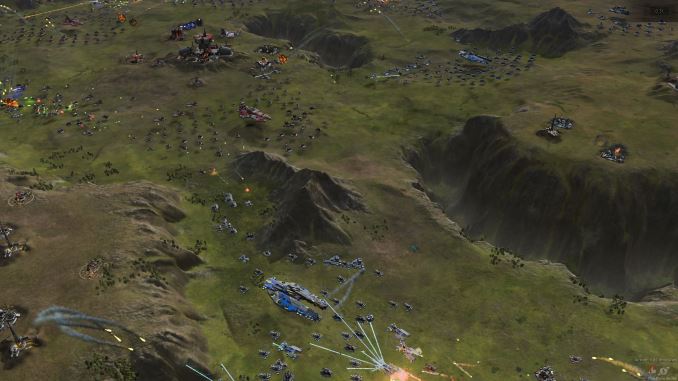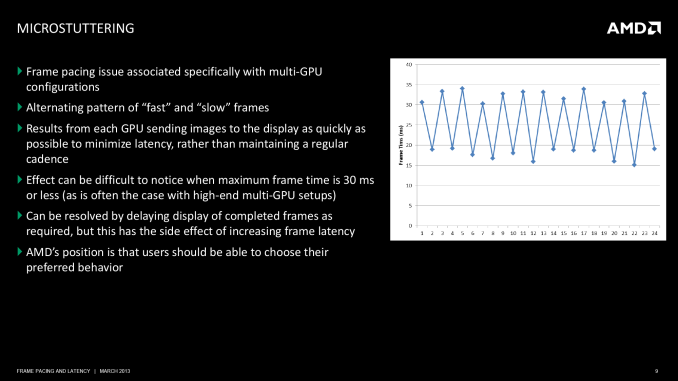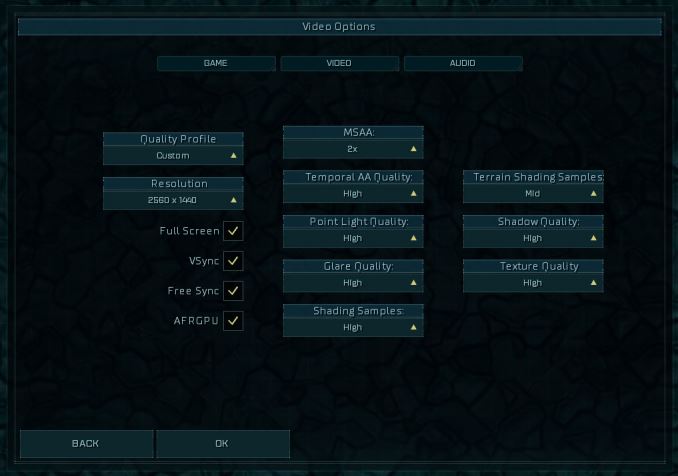GeForce + Radeon: Previewing DirectX 12 Multi-Adapter with Ashes of the Singularity
by Ryan Smith on October 26, 2015 10:00 AM ESTAshes of the Singularity: Unlinked Explicit Multi-Adapter with AFR
Based off of Oxide’s Nitrous engine, Ashes of the Singularity will be the first full game released using the engine. Oxide had previously used the engine as part of their Star Swarm technical demo, showcasing the benefits of vastly improved draw call throughput under Mantle and DirectX 12. As one might expect then, for their first retail game Oxide is developing a game around Nitrous’s DX12 capabilities, with an eye towards putting a large number of draw calls to good use and to develop something that might not have been as good looking under DirectX 11.
That resulting game is Ashes of the Singularity, a massive-scale real time strategy game. Ashes is a spiritual successor of sorts to 2007’s Supreme Commander, a game with a reputation for its technical ambition. Similar to Supreme Commander, Oxide is aiming high with Ashes, and while the current alpha is far from optimized, they have made it clear that even the final version of the game will push CPUs and GPUs hard. Between a complex game simulation (including ballistic and line of sight checks for individual units) and the rendering resources needed to draw all of those units and their weapons effects in detail over a large playing field, I’m expecting that the final version of Ashes will be the most demanding RTS we’ve seen in some number of years.
Because of its high resource requirements Ashes is also a good candidate for multi-GPU scaling, and for this reason Oxide is working on implementing DirectX 12 explicit multi-adapter support into the game. For Ashes, Oxide has opted to start by implementing support for unlinked mode, both because this is a building block for implementing linked mode later on and because from a tech demo point of view this allows Oxide to demonstrate unlinked mode’s most nifty feature: the ability to utilize multiple dissimilar (non-homogenous) GPUs within a single game. EMA with dissimilar GPUs has been shown off in bits and pieces at developer events like Microsoft’s BUILD, but this is the first time an in-game demo has been made available outside of those conferences.
In order to demonstrate EMA and explicit synchronization in action, Oxide has started things off by using a basic alternate frame rendering implementation for the game. As we briefly mentioned in our technical overview of DX12 explicit multi-adapter, EMA puts developers in full control of the rendering process, which for Oxide meant implementing AFR from scratch. This includes assigning frames to each GPU, handling frame buffer transfers from the secondary GPU to the primary GPU, and most importantly of all controlling frame pacing, which is typically the hardest part of AFR to get right.
Because Oxide is using a DX12 EMA AFR implementation here, this gives Ashes quite a bit of flexibility as far as GPU compatibility goes. From a performance standpoint the basic limitations of AFR are still in place – due to the fact that each GPU is tasked with rendering a whole frame, all utilized GPUs need to be close in performance for best results – otherwise Oxide is able to support a wide variety of GPUs with one generic implementation. This includes not only AMD/AMD and NVIDIA/NVIDIA pairings, but GPU pairings that wouldn’t typically work for Crossfire and SLI (e.g. GTX Titan X + GTX 980 Ti). But most importantly of course, this allows Ashes to support using an AMD video card and an NVIDIA video card together as well. In fact beyond the aforementioned performance limitations, Ashes’ AFR mode should work on any two DX12 compliant GPUs.
From a technical standpoint, Oxide tells us that they’ve had a bit of a learning curve in getting EMA working for Ashes – particularly since they’re the first – but that they’re happy with the results. Obviously the fact that this even works is itself a major accomplishment, and in our experience frame pacing with v-sync disabled and tearing enabled feels smooth on the latest generation of high-end cards. Otherwise Oxide is still experimenting with the limits of the hardware and the API; they’ve told us that so far they’ve found that there’s plenty of bandwidth over PCIe for shared textures, and meanwhile they’re incurring a roughly 2ms penalty in transferring data via GPUs.
With that said and to be very clear here, the game itself is still in its alpha state, and the multi-adapter support is not even at alpha (ed: nor is it in the public release at this time). So Ashes’ explicit multi-adapter support is a true tech demo, intended to first and foremost show off the capabilities of EMA rather than what performance will be like in the retail game. As it stands the AFR-enabled build of Ashes occasionally crashes at load time for no obvious reason when AFR is enabled. Furthermore there are stability/corruption issues with newer AMD and NVIDIA drivers, which has required us to use slightly older drivers that have been validated to work. Overall while AMD and NVIDIA have their DirectX 12 drivers up and running, as has been the case with past API launches it’s going to take some time for the two GPU firms to lock down every new feature of the API and driver model and to fully knock out all of their driver bugs.
Finally, Oxide tells us that going forward they will be developing support for additional EMA modes in Ashes. As the current unlinked EMA implementation is stabilized, the next thing on their list will be to add support for linked EMA for better performance on similar GPUs. Oxide is still exploring linked EMA, but somewhat surprisingly they tell us that unlinked EMA already unlocks much of the performance of their AFR implementation. A linked EMA implementation in turn may only improve multi-GPU scaling by a further 5-10%. Beyond that, they will also be looking into alternative implementations of multi-GPU rendering (e.g. work sharing of individual frames), though that is farther off and will likely hinge on other factors such as hardware capabilities and the state of DX12 drivers from each vendor.
The Test
For our look at Ashes’ multi-adapter performance, we’re using Windows 10 with the latest updates on our GPU testbed. This provides plenty of CPU power for the game, and we’ve selected sufficiently high settings to ensure that we’re GPU-bound at all times.
For GPUs we’re using NVIDIA’s GeForce GTX Titan X and GTX 980 Ti, along with AMD’s Radeon R9 Fury X and R9 Fury for the bulk of our testing. As roughly comparable cards in price and performance, the GTX 980 Ti and R9 Fury X are our core comparison cards, with the additional GTX and Fury cards to back them up. Meanwhile we’ve also done a limited amount of testing with the GeForce GTX 680 and Radeon HD 7970 to showcase how well Ashes’ multi-adapter support works on older cards.
Finally, on the driver side of matters we’re using the most recent drivers from AMD that work correctly in multi-adapter mode with this build of Ashes. For AMD that’s Catalyst 15.8 and for NVIDIA that’s release 355.98. We’ve also thrown in single-GPU results with the latest drivers (15.0 and 358.50 respectively) to quickly showcase where single-GPU performance stands with these newest drivers.
| CPU: | Intel Core i7-4960X @ 4.2GHz |
| Motherboard: | ASRock Fatal1ty X79 Professional |
| Power Supply: | Corsair AX1200i |
| Hard Disk: | Samsung SSD 840 EVO (750GB) |
| Memory: | G.Skill RipjawZ DDR3-1866 4 x 8GB (9-10-9-26) |
| Case: | NZXT Phantom 630 Windowed Edition |
| Monitor: | Asus PQ321 |
| Video Cards: | AMD Radeon R9 Fury X ASUS STRIX R9 Fury AMD Radeon HD 7970 NVIDIA GeForce GTX Titan X NVIDIA GeForce GTX 980 Ti NVIDIA GeForce GTX 680 |
| Video Drivers: | NVIDIA Release 355.98 NVIDIA Release 358.50 AMD Catalyst 15.8 Beta AMD Catalyst 15.10 Beta |
| OS: | Windows 10 Pro |













180 Comments
View All Comments
TallestJon96 - Monday, October 26, 2015 - link
Crazy stuff. 50% chance either AMD or more likely NVIDIA locks this out via drivers unfortunately.To me, the most logical use of this is to have a strong GPU rendering the scene, and a weak gpu handling post processing. This way, the strong GPU is freed up, and as long as the weak GPU is powerful enough, you do not have any slow down or micro-stutter, but only get an improvement in performance, and the opportunity to increase the quality of post processing. This has significantly less complications than AFR, is simpler than two cars working on a single frame, and is pretty economical. For example, i could have kept my 750 ti with my nee 970, had had the 750 ti handle post processing, and the 970 do everything else. No micro stutter, relatively simple,and inexpensive, all while improving performance and post-processing effects.
Between multi-adapter support, multi-core improvements in DX12, free-sync and Gsync, HBM, and possibly X-point, there is quite a bit going on for PC gaming. All of these new technologies fundementally improve the user experience, and fundementally improves the way we render games. Add in the slow march of moore's law, an over due die shrink next year for GPUs, and the abandonment of last generation consoles, and the next 3-5 years are looking pretty damn good.
Refuge - Tuesday, October 27, 2015 - link
I think that would be the dumbest thing either one of them could do.Also, if they locked it out, then their cards would no longer be DX12 compliant. Losing that endorsement would be a devastating blow for even Nvidia.
Gigaplex - Tuesday, October 27, 2015 - link
NVIDIA has a habit of making dumb decisions to intentionally sabotage their own hardware when some competitor kit is detected in the system.tamalero - Monday, October 26, 2015 - link
Question is.. will Nvidia be able to block this feature on their drivers? not the first time they tried to block anything that is not Nvidia (see PhysX that DO work fine with AMD + Nvidia combos, but disabled on purpose)martixy - Monday, October 26, 2015 - link
What about stacking abstractions? Could you theoretically stack a set of linked-mode for main processing on top of unlinked mode for offloading post to the iGPU?Ryan Smith - Monday, October 26, 2015 - link
Sure. The unlinked iGPU just shows up as another GPU, separate from the linked adapter.lorribot - Monday, October 26, 2015 - link
From a continuous upgrade point of view you could buy a new card shove it in as the the primary and keep the old card as a secondary, it could make smaller more frequent upgrade steps a possibility rather than having to buy the one big card.Would be interesting to see something like a HD7850 paired with a GTX 780 or R290
boeush - Monday, October 26, 2015 - link
In addition to postprocessing, I wonder what implications/prospects there might be when it comes to offloading physics (PhysX, Havoc, etc.) processing onto, say the iGPU while the dGPU handles pure rendering... Of course that would require a major upgrade to the physics engines to support DX12 and EMA, but then I imagine they should already be well along on that path.Gigaplex - Tuesday, October 27, 2015 - link
That was already possible with DirectCompute. I don't think many games made much use of it.nathanddrews - Tuesday, October 27, 2015 - link
This is my fear - that these hyped features will end up not being used AT ALL in the real world. One tech demo that proves that you can use different GPUs together... but how many people with multi-GPU setups will honestly choose to buy one of each flagship instead of going full homogenous SLI or CF?It seems to me that the only relevant use case for heterogenous rendering/compute is to combine an IGP/APU with a dGPU... and so far only AMD has been pushing that feature with their Dual Graphics setup, despite the availability of other solutions being available. If it were realistic, I think it would exist all over already.